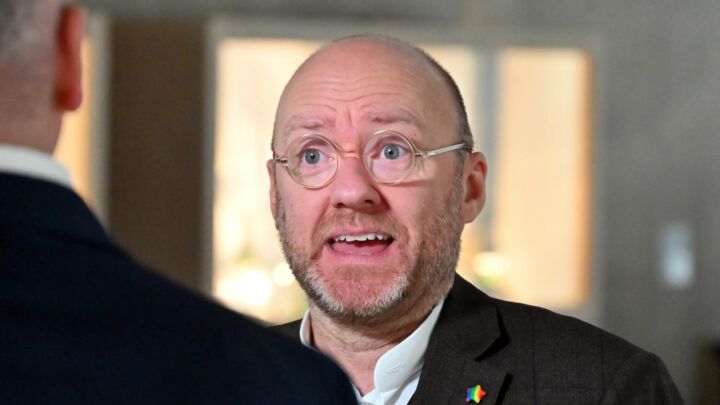Reawakening the ‘yellow peril’
An exhibition at the Battersea power station reveals the West’s double standards when it comes to Chinese modernisation.

The Serpentine gallery has chosen Battersea Power Station as the setting for a new exhibition of Chinese art, China Power Station: Part 1, and has seemingly set out to represent modern China on the enormous brownfield site – a bleak post-industrial landscape with indecipherable markings, unsettling sounds, confusion, bicycles heading in many different directions and structures on an inhuman scale. With a tarmac area bigger than Trafalgar Square, and a building that sits arrogantly denying the visitor’s significance, the site echoes Tiananmen and China’s industrial might.
The Chinese art is very well curated and the location is apt, but there is an odd contrast at this exhibition. On the ground floor of Turbine Hall B, the developers are showcasing their regeneration plans for the site – a flashy and rousing presentation that had me yearning to win the lottery so that I could afford to buy a yuppie flat in this ‘creative hub’, as the developer calls it. On the floors above, the Chinese exhibition reveals that this set of artists view China’s regeneration with deeply morbid pessimism. For them, regeneration has two overwhelming downsides: the dehumanising and exploiting effects of factory work coupled with the destructive and dislocating nature of urban renewal.

The sound installation that squawks and growls as you enter the grotesquely run-down interior of the power station is both comedic and unnerving. Its primordial sounds match the sense that something terrible occurred in this over-scaled post-apocalyptical ruin. A viewing platform allows visitors to walk out into the middle of the empty and roofless Turbine Hall A and admire the destruction.
Upstairs the video installations evoke the negative aspects of economic revival in an effective way. Cao Fei’s film is especially striking. He depicts workers in an Osram factory as generic itinerants – until the camera catches a glimpse of their humanity and we wake from the hypnosis of seemingly watching a relentless machine. Jia Zhang-Ke’s films of a man waiting in a grubby waiting room for a train that never stops and of Chinese people catching commuter buses in a bleak industrial wasteland both capture the depressing reality for many ordinary Chinese striving for economic success.
Zhang Pei-Li cuts footage of 1950s party-faithfuls joyously clapping their hands with random statements by party officials, giving the effect of ridiculing Chinese government as a kind of sit-com. Qu An-Xong’s animation using traditional Chinese inks depicting a developing but degrading cityscape are somewhat literal, if very well executed. The damp, dark and degraded setting for the installations elicits an unsettling feeling, heightening the overall sense of depression.

But it is the only non-video part of the exhibition which has the strongest impact; Gu Dexin’s installation of 100,000 caged-in apples set up in a rather less dank part of the power station. The apples are of course slowly rotting, but at first glance they appear quite fresh. Dexin seems to be suggesting that aggregation and appropriation by market and by state will degrade China’s humanity.
The China Power Station: Part 1 exhibition is set up to contradict the Chinese government’s economic and social policies. Certainly, these artists’ voices need to be heard – China’s economic revival has certainly come at some cost, especially for the 200million internal migrants denied basic citizenship rights by the state and subjugated by the market. But low wages and social dislocation are not news to even the most sporadic China-observer. What this exhibition reveals instead is a Western fetish of understanding China as an industrial monolith; it reveals the desire to demonise its economic development because of its enormous size and its supposedly impenetrable culture.
I must confess the derelict power station and the video installations oddly resonated with my own experience of modern China, mostly because of my inherent Western preconceptions. Take a look at Edward Burtynsky’s pictures to see what I mean (1). They are of a China that exists in our minds, of a post-industrial monster waking from its sleep – the ‘yellow peril’ of yesteryear reborn. But if you live and work amongst the Chinese you will find optimism. Whether this is because people have swallowed the Party’s rhetoric or because there is a genuine chance of success, to understand China in terms of the depressing video installations of the Serpentine exhibition is an easy way out.
Which is precisely why the flashy presentation of Battersea’s redevelopment jarred so much. Why is it we can celebrate developments such as the Tate Modern and think of grand schemes for Battersea Power Station, and yet at the same time indulge in one-dimensional stereotyping when it comes to Chinese regeneration?
China has rejoined the world with a bang and its artists are contesting the manner of that change, but this exhibition reveals our double standards when it comes to modernisation. China and its people deserve the economic success they are striving for.
The Serpentine Gallery presents China Power Station: Part 1 at Battersea Power Station runs until 5 November 2006. For further details go to the Serpentine Gallery’s website.
Tristan Edmondson is an intern at spiked. He has an MA in Chinese Studies and has lived and worked in China.
(1) Edward Burtynsky
To enquire about republishing spiked’s content, a right to reply or to request a correction, please contact the managing editor, Viv Regan.








Comments
Want to join the conversation?
Only spiked supporters and patrons, who donate regularly to us, can comment on our articles.